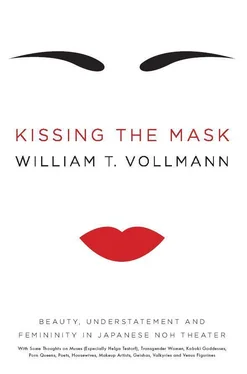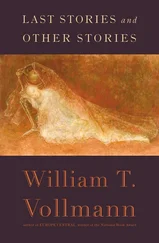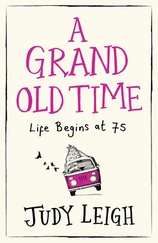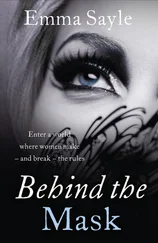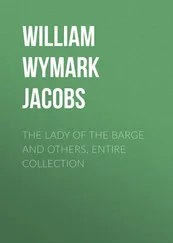17Still another of my oversimplifications, as you’ll see.
18Distinguished below, p. 63.
19Eyebrow depilation was more typical of Heike than of Genji aristocrats. For this reason, Genji roles require more masculine-looking masks. Why were high eyebrows considered beautiful then? Perhaps for the same reason that they are today. One zoologist who has turned his attention to women’s bodies believes that raised eyebrows remind us of a surprised child’s, and may thereby connote just-ripe nubility.
20“Mr. Umewaka, how far away do you think that someone in your audiences can sit and still appreciate the differences between masks?” — “In my theater,” he replied, “you can be at the very rear. I think that’s the limit. In the past, however, the place where the seating began was as far as it is from the stage to the very back of my theater! As you know, the stage was part of a shrine, and the audience had to sit some distance from it. In such a situation, over-acting is appropriate.” — It seemed to me that he might have given our collective discernment too much credit here. Whenever I attended his performances I used my binoculars and I still longed to be closer.
21In The Tale of Genji, from which so many Noh plays derive, the exact age when Genji deflowers his ward Murasaki is not stated, but she seems to have been quite young: “ ‘How tall you have grown since last I saw you!’ he said and pulled up her little curtain of honor… she had indeed grown up into as handsome a girl as you could wish to see; nor was she any longer at an age when it was impossible for him to become her lover. He constantly hinted at this, but she did not seem to understand what he meant.” After he forces himself on her, “he understood that her distress was due merely to extreme youth and inexperience, and was not at all put out.”
22The Noh expert Jeff Clark adds here: “Their hos and yas indicate where they are in the score, but the main function seems to be to intensify emotion and atmosphere.”
23“He knew Mishima personally,” inserts Jeff Clark, “but not closely, as he was only 23 when Mishima committed suicide, but he has referred to him as Mishima-sensei, sensei meaning… ‘teacher.’ ”
24In a brief essay entitled “On the Forty-Fifth Anniversary of My Stage Career,” he lovingly recalls his “indoctrination” at the hands of his grandfather: “For example, in the cherry blossom-viewing scene of Kurama Tengu , which was my first stage performance, he painted the glories of spring in vivid imagery, telling me, ‘Look how beautifully the cherry trees are blooming, my boy,’ and thus drew me into the scene with his eloquence.”
25One recent head of the Kongo School (he died in 1951) reported that in a certain village where he performed this role, people said, “If Okina does not come, the rice will not grow.”
1“Monkey music.” So called because the monkeys on Mount Hiei spied on the deity Kuni no Tokotachi no Mikoto, who performed Noh dances for his own entertainment. The monkeys imitated; humans saw the monkeys and learned from them.
2Another Westerner expresses this phenomenon with different feelings: “Originally it was considerably more natural than it is now. The years have widened the gulf between it and its origin, and have intensified its artificiality and its museum-like mustiness.” In the consistently jaundiced account of Eric C. Rath, who emphasizes how over time authority became centralized in the Noh Schools, thereby rigidifying the medium and disempowering variant voices, this slowing down and ritualization of Noh occurred in large part at the end of the nineteenth century, as an expression of elitism, and ultimately of militarism, “a timeless image of imperial rule with an idealized and ordered vision of a disciplined public.” Rath asserts that these alterations in Noh were, in effect, lies in the cloak of history.
3In “Sumidagawa,” discussed below, p. 362.
4From a certain train journey in Japan I recollect sleepwalled valleys; reddish-brown foliage mixes with the green vertical streamers of fog; and there comes a cool silent rain under whose blows the gunmetal river twitches as if trout-stirred. My window occludes the shoulders of rust-leaved mountains. For an instant, the fog offers me a single leafless branch.
5In The Tale of the Heike he starves himself out of regret at not being able to reward the loyalty of a retainer who has visited him. This alternate ending is scarcely happier. When I think of Shunkan, I remember Hokusai’s simple, vivid sketch: Long and skinny, his rags resembling leaves or scales, he has become a part of his tiny rock-island. Crosslegged, he leans back with closed eyes, waiting for eternity to finish.
6Mishima wrote a typically gloomy modernization of this last.
7Noh music probably entered its present incarnation around the beginning of the sixteenth century.
8Meanwhile, one Noh critic asserts that “it is… possible for an actor to deliver a line perfectly without understanding it.”
9The sad life of Ono no Komachi figures in chapters 26 and 28.
10This must be the only place in the book when I use “ancient” in so extremely relative a sense. The most gorgeous costumes tend to date no earlier than the Edo period, when fabric-dyeing was perfected.
11Also transliterated “Konparu.”
12“Our school is the most refined,” Mr. Umewaka once said to me, “so maybe it doesn’t have as many attributes as the others. We employ more subtle, more delicate expressions.” (The Noh expert Jeff Clark remarks that this “comment expresses the connection of refinement with simplicity. The greater the artist, the less he needs in his bag of tricks.”) Dr. Yokoyama Taro distinguishes the Umewaka School thus: “Umewaka belongs to Kanze-Ryu, the largest of Noh schools. Kanze’s players have a reputation of enacting embellished stages, though not as much as the flashy Kita-Ryu people. In comparison, the schools Komparu and Kongo are both of them more restrained, preferring delicacy in their expressions. Within the Kanze School, the Umewaka Family and Tessen-kai (or Tetsunojo Family) have contrasted themselves with [the] Kanze Family (the head house) by introducing the minute vocal nuances originated in Hosho Ryu (another of the main five schools…), thereby taking the direction of more aesthetic delicacy. [The] Umewaka Family and Tessen-Kai are… stylistically close together, but while the latter has a comparatively democratic, rivalry-free system, Umewaka sticks to the ‘Iemoto’ (head family) tradition…”
1The evolution of masks may have proceeded as follows: Greek tragedy masks carried on the Silk Road as trade goods helped inspire the huge Chinese gigaku masks, which arrived in Japan in the seventh century. These soon gave way to smaller bugaku masks for court dances; next came the still smaller gyodo masks for Buddhist processions. Finally, smallest of all, Noh masks arrived, beginning in the tenth century with Okina’s wooden face.
2The charming Japanese tendency to subcategorize is further seen in Utamaro’s listing of the three best types of vulva: takobobo, todatebobo and kinchakubobo (octopus, which sucks; trapdoor, which grips; purse, which is tight).
3Other sources say simply that the ko-omote represents a girl of fifteen, the waka-onna and magu-jiro a woman of about twenty-five.
4Even slighter is the difference between a waka-onna and a fushikizo. In this book the latter will be discussed only briefly, in regard to the great play “Matsukaze.”
5This story enthralled Mishima Yukio, one of whose reasons for cutting his belly open was that his body was losing its youthful perfection. In his own version of the Noh, as we shall see, the old woman is a kind of vampire who murders youth with an illusion of her beauty.
Читать дальше
